The car gains speed with desire and the sound, although not orgasmic like the 458 Italia, impresses you with its depth, while the wind begins to be heard too, massaging the fine bodywork of Italian design.
I kiss the 210 per hour marker while I slightly hollow to throw myself into the first left turn of the track, a very fast downhill that gives way to the second braking with almost no escape. I throw myself on the brakes and I negotiate the curve with all the confidence of having spent almost 40 minutes doing laps with the 4C on the circuit. I give gas before the apex and no, I don't make the skid of my life, but that "feeling" of mechanical connection with the road, that feeling of a cornering machine that is giving me what I have in my hands gives me a placid feeling of happiness. A grimace, a gesture, a smile escapes me as I face the short straight to the next curve, where Dani Murias is with the camera to record on video our misdeeds and I, meanwhile, I can't stop thinking: Is this really an Alfa Romeo?
For a moment I get carried away... Light at the end of the tunnel? Is this Alfa a sign of what's to come? Or is it just another flash of a demonstration of know-how in the middle of a product range that can't find its place and personality? Anyway, I want to keep having fun, even if the people at the circuit are pushing me to finish filming, because the ambulance has to leave...
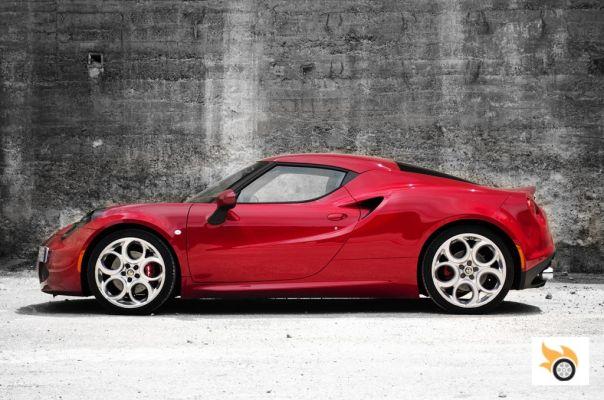
This adventure started when a few months ago a good friend told us that Difisa (yes, the people who prepared our Abarth 500 of the Long Duration test), was going to organize an event at the circuit to show the Alfa Romeo 4C to the customers who had already bought it and were waiting for it; and also to other potential customers.
With synaesthetic thinking I instinctively asked if they had the track rented for the whole day or if we would have a chance to steal a couple of hours of track for ourselves. A couple more calls and some investment left us with the track slot. We had to get the car... And that took another couple of calls.
The operation wasn't entirely straightforward. With little press availability for a limited series car, and more than 2,000 kilometers to do in three days, plus recording, photographs and everything else, the adventure was exciting and disturbing.
So, last week I got off the RCZ-R near Madrid and stood in front of this beautiful Italian sports car, which I hadn't seen in detail since the Geneva Motor Show.
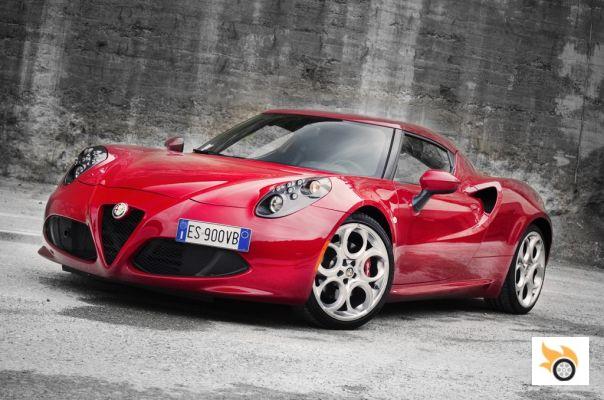
The bodywork of the Alfa Romeo 4C is not signed by Pininfarina or Bertone, but it doesn't need to have a big stamp behind it to be a work of art. The names behind the stunning silhouette are those of Alessandro Maccolini, Marco Tencone and Lorenzo Ramaciotti, people who are also behind Maserati's recent creations, with works of art like the Alfieri also on their CVs.
The history
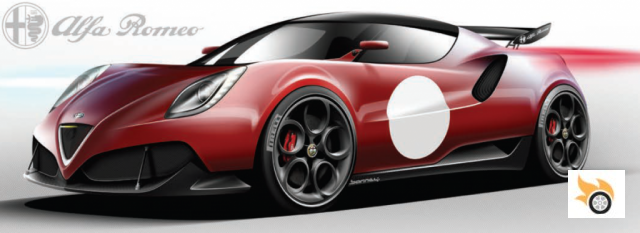
But before we get into the formal aesthetic analysis, as this is going to take a long time, let's start with the conception of the project. The idea of creating a sports car within Fiat, with a carbon fibre chassis, two-seater, lightweight, "Lotus Elise-like", had been assigned to Abarth. The scorpion firm, as we told you years ago exclusively here, was going to be able to have its "halo" car.
The development of the carbon fiber monocoque was going to be its main differentiating factor with respect to Lotus products, and to the supposed rivals that were going to come from Alpine, Caterham and Volkswagen. The chassis was designed by Dallara and it seemed that the heart of the car would be provided by the MultiAir 1.4 in 180 horsepower version. The car would have a final price of about 40,000 euros.
But life takes many turns and at Fiat what is black today can be white tomorrow. Alfa Romeo needed to reinvent itself and be reborn. Marchionne had a master plan for this, which was based on erasing and breaking with all the company's past since the purchase of Fiat, recovering the traditional values of sportiness, technology, passion and design. His bet needed a halo car to embody all this string of ambitions, as had already been done with the Alfa Romeo 8C as a "driving force" for Giulietta and MiTo.
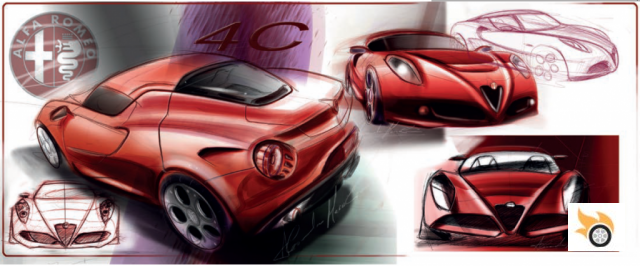
Thus, the Abarth project, which it had already been seen that it would be difficult to meet the specifications of a price of over 40,000 euros, because of its expensive carbon fibre frame, was immediately transferred to Alfa Romeo. All this happened at breakneck speed, which caught many by surprise. On paper, Maserati had also secured a version of this car, based on the Abarth and fitted with a more powerful engine, but all of a sudden it seemed that this project was also cancelled.
In fact, according to Alfa Romeo, the whole project was rethought almost from scratch, and the team assembled in Modena is credited with the complete development of the carbon fiber chassis, now manufactured for them by Adler Plastic, renouncing Dallara and the production they offered, perhaps dissatisfied with the price and development offered for the Abarth.
The 2011 Geneva Motor Show arrived and Alfa surprised everyone with a completely unexpected two-seater mid-engined sports car. Few people took Fiat seriously at the time, promising to put it into production "in a matter of two years at a price around €45,000 or €50,000".
They added that the idea was to "put driving fun, lightness and agility" before "power and comfort". We rubbed our eyes - were they serious? Were they going to launch the car?
Geneva 2013 was the answer: in two years they had gone from concept prototype to a 100% functional and marketable car, both in Europe and the United States, with the idea of using it as the flagship of the reinvented Alfa Romeo.
All of us present were talking about the "spidery" optical groups, which spoiled the whole, the only ostensible change of the car at first sight. Although the reality is that each and every aesthetic aspect of the car had to be touched and retouched to adapt the car to its final format. The collaboration with Dallara was abandoned along the way and the car was developed entirely in Modena, in Maserati's offices, creating the seed of what is now going to be the "skunkworks" team that will be in charge of bringing all the new generation Alfa Romeo cars to life around its brand new rear-wheel drive platform. There wasn't a single curve or measurement that wasn't changed, but the aesthetic achievement was in keeping the DNA intact.
The aesthetics, live
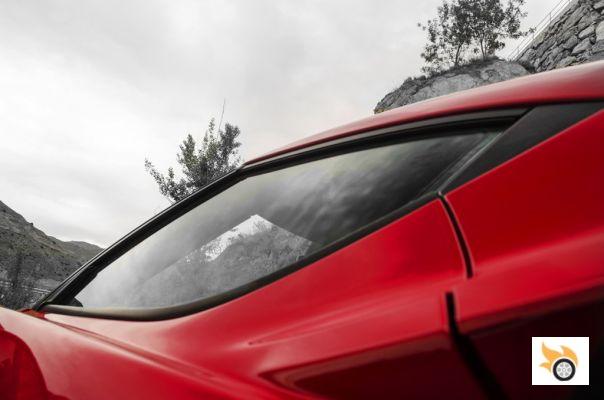
Every shape, every detail, makes you fall in love, but the best thing about the design is that it works as a whole as well as when we stop to scrutinize its small-scale ornamentation.
The 4C's lines follow a radically different principle, like any Alfa Romeo, to the principle employed by many other manufacturers. Where McLaren or Porsche say "form follows function", Alfa says "form comes first, but it is also function". What does this mean? It means that the designers, as is already the case at Ferrari and Maserati, work with degrees of freedom unknown in other companies, actively collaborating with the engineers in a constant exchange of ideas to negotiate the final design of the car. Where the designer wants and can put a curve, an air intake or a character line, he also wants it to serve a purpose.
In a way, it is what in design is defined as "holistic design", understanding the design of each component, curve, shape, as a whole. Understanding the design of the car as a whole from its shapes, but also understanding that each curve has a visual design, an aesthetic and at the same time a mechanical function. This is a far cry from the "warrior" approach of other companies, where the design is marked by the demands of engineering, or where there is a permanent struggle between form and function.
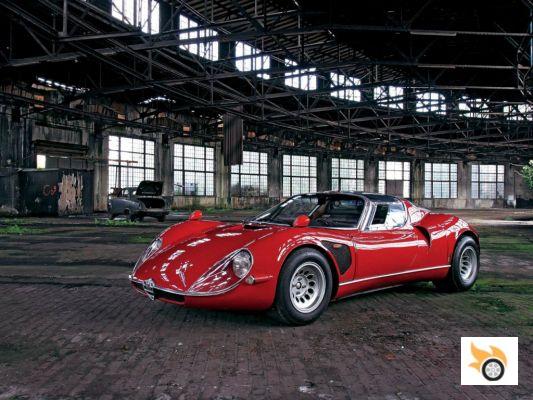
The result of this Alfa Romeo approach is... sublime. The Milanese brand (well, now Turinese, or from Modena... whichever way you want to look at it), refers to the Alfa Romeo 33 Stradale by the genius Franco Scaglione as a major reference. Certainly the parallels are there, very present.
From the 33 Stradale we don't see a single common feature, but a common spirit. Sharp ovoid headlights, air intakes just behind the wheels, a truncated rear, wide and dominated by two circular optical groups, a similar waist line, a panoramic windshield continued visually with the side windows, a sharp hood, wheels that dominate the stamp with the design of circles arranged in a radial position, the rear hood that lets you guess the engine through a shield-shaped glass ...
But probably the closest representative to the 4C in concept is the 1966 Alfa Romeo Scarabeo concept by OSI coachbuilders. Where the 33 Stradale was a racing car with a longitudinal mid-mounted V8 engine, dressed in luxury for road use, the Scarabeo had, like the 4C, an inline four-cylinder and many other parts borrowed from the standard Giulia GTA. The problem with the Scarabeo is that, while conceptually it may be more similar, aesthetically, the 4C breathes and smells like a 33 Stradale.
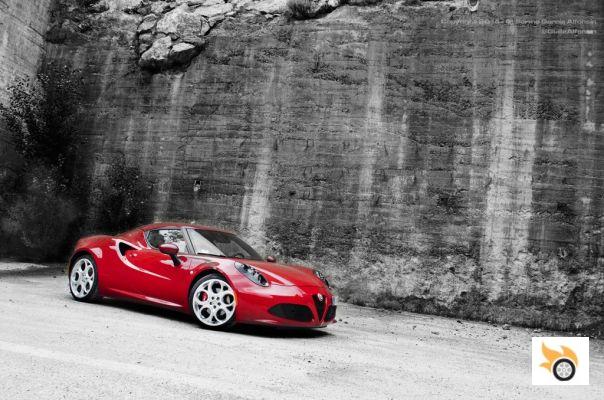
However, focusing on the "today" and leaving aside past references, the front of the car is dominated by the triangular "Alfa" grille, seconded by the side whiskers. The grille generates the "V" marked on the bonnet, while the semi-elliptical light clusters generate the front wheel arches and mark the waist line, in accordance with the less "giugiaristic" traditions, if I may say so. The front wheel arches are pronounced, muscular, powerful, and they are surrounded by a revamped design of the typical rims, in 18 inches at the front and 19 at the rear on this unit, with radially arranged circles, which are also specially elaborated in three dimensions.
The beltline falls slightly downwards, before rising upwards, as on the 8C or the 33 Stradale. The front window is panoramic and the A-pillars are embedded in black to conceal them, giving the impression of "continuous glass" in the style of a "full-face helmet" that reminds us somewhat of the Lancia Stratos.
The side is dominated by the air intake that generates the styling line halfway up the door, gains strength and crowns the rear wheel arch, creating a generous muscular hip that frames the rear wheel arch. A sill plate (or valance, as Dani more correctly puts it) juts out forward, connecting the two wheel arches to give the car more punch and dynamism.
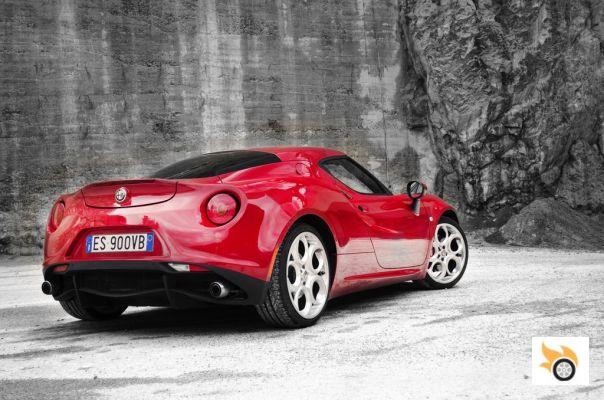
The rear three-quarter is another aesthetic marvel. The glass that covers the engine takes the form of a shield, guarded by two vents responsible for keeping the compartment at a suitable temperature, reminiscent of those used in many Ferrari since the 360. The truncated rear has a nice "duck tail" to offer aerodynamic load, and the extreme position of the large round LED headlights that are responsible for the taillights emphasize the width of the whole. The rear diffuser is fully functional and is supported by two exhaust tailpipes, one on each side, with a twin tailpipe - a design feature already used on the Abarth 500. Personally, I think that a more generous tails would give more packaging to the ass.
The most vital thing, the most important thing about the external language of the car and something that is derived throughout its interior, technology and even driving, is that Alfa Romeo has been able to create an "instant classic" aesthetically, drawing on visual DNA from the past, but without falling into the "retro". The 8C, in that sense, was a more retro car, more faithful to the past. The Alfa Romeo 4C is more technical, more modern. It perfectly combines the past, but also future projection. It's modern, but at the same time instantly recognisable. It's... a stroke of genius, a good design job.
All in all, the car looks like a slightly cropped supercar. It reminds me of a scaled-down 360 Challenge Stradale (they don't share lines, but there's a "something"). Some say it's "maybe too wide", some say the headlights are "ugly". I tell you that any complaint you might have read about it in the specs or seen pictures will vanish when you see it in front of you. It's one of those short, wide sports cars that give off dynamism when standing still and that make people fall in love with it instantly. You forget about the headlights, you forget about any criticism. You fall in love... Even for the complainer I have a reply: you know that the 4C can now be ordered with the traditional headlights of the 4C Spider if you don't like these...
Cabin
For me, the first surprise was when I opened the door and sat inside. In Geneva we hadn't been able to test the seat and enjoy the car, as they were locked up tight. After pulling the door handle (yes, the same of a Ferrari 360...), the huge side beams of the carbon fiber chassis make you have to pull your leg further in than normal. It is, in that, a typical carbon fibre car, although in that too it reminds me of a Lotus Elise or Exige.
You throw yourself into the seat and find yourself in an ultra-low position, as it should be. You're just a few millimetres from the tarmac. I place the bench with its only two possible adjustments: longitudinal and backrest inclination, to leave my feet at the ideal distance from the pedals.
The bottom bracket is a marvel, plain and simple. It's practically the same as the one used by Ferrari in their models, with lower articulation and perfectly placed genuine aluminium pedals. The left leg has to be a bit more twisted than usual to reach the footrest and free the front wheel arch.
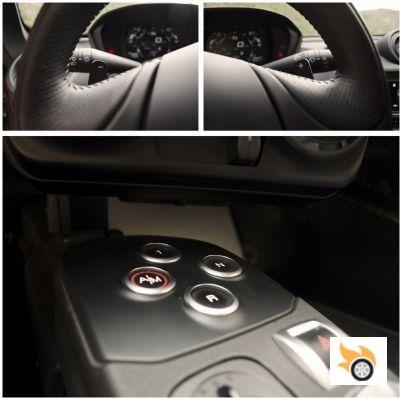 The multi-adjustable steering wheel is of limited diameter, sharing the heart of its airbag with the Fiat-Abarth 500, while its rim, with a flat base, is also very similar in thickness and shape to that of the Abarth 500, although smaller in diameter. Fortunately here it falls much better positioned. It tilts for height and is depth adjustable. Finding a perfect position is a matter of seconds; and it falls close enough and upright enough.
The multi-adjustable steering wheel is of limited diameter, sharing the heart of its airbag with the Fiat-Abarth 500, while its rim, with a flat base, is also very similar in thickness and shape to that of the Abarth 500, although smaller in diameter. Fortunately here it falls much better positioned. It tilts for height and is depth adjustable. Finding a perfect position is a matter of seconds; and it falls close enough and upright enough.
With your butt well seated, you realize that your back is perhaps a little more vertical than some would like, but personally I'll tell you that I felt immediately at home. I look around then and immediately realise that anyone who has dared to compare this car to a Cayman has either not ridden it, or has no idea what they are talking about. The Porsche may share certain aspects (absolute performance, weight, "economical" mid-engine sports car), but without even starting the car you realize that nothing, absolutely nothing has to do with the car from Stuttgart and this Alfa.
I will tell you that the feeling inside the car is similar, in terms of layout, driving position and austerity, to the one you get in a Lotus Exige, an Elise or a radical Ferrari (a 458 Speciale or an Enzo). Compared to the Lotus, as Dani pointed out to me after sitting in it, the Alfa is much more spacious in width. He's not wrong: where in an Elise or an Exige you're practically shoulder to shoulder with the passenger, the Alfa has space as wide as a... 360 (and we're still on the recurring theme, aren't we?). The dashboard clearly shows that the people who made this car are the same people who made the Ferrari "specials": it's spartan, and the layout of the elements is very similar. It's all a single piece of hard plastic, which takes the necessary shapes to tilt the controls towards the driver and to also form the air vents for the air conditioning system. Underneath this plastic skin, out of sight, are a bunch of pylons on which all the technical elements of the car's cabin sit, in order to reduce the number of different components, reduce weight and simplify assembly.
Although, as I say, sitting inside feels like being in a Ferrari of the latest generation, there is a vital difference: where the 458 has a display of quality and materials on a par with a £200,000 car, Alfa Romeo has had to cut back here, especially to adjust the price of the car to the final target, without losing the ability to offer a carbon fibre monocoque chassis, the main money-spinner.
So, a quick glance at the cockpit elements will make you recognize a lot of parts reused from the Fiat group's body bank: sequential gear knob from the Fiat 500, handbrake lever from the Abarth 500, mirror and door window controls from the Alfa Romeo MiTo, steering wheel paddles identical to those of the Giulietta, indicator and light controls taken from the MiTo... And the list goes on and on. We were particularly struck by the use of the "aviation type" switches under the radio, discarded for reasons we don't understand from the Giulietta after the restyling (we think they're beautiful and have a great feel), here they find a new life, and... they look great.
The radio is a Parrot OEM which we'll talk about later, because it can be basically useless 90% of the time you'll be driving this car.
The interior is spartan and radical, more Lotus or 458 Speciale than anything else.
The seats at first glance may look very flat-backed. The truth is that they have few petals to hold you back, and give the feeling that you're going to move around a lot in the cockpit when you demand G-forces from the tyres, but the reality is that they end up surprising you. They're comfortable, and they hold more than well, more than what the eye tells you. The passenger seat, by the way, is fixed in its settings, unless you order the adjustable option. Alfa Romeo says this is to save weight. Curious.
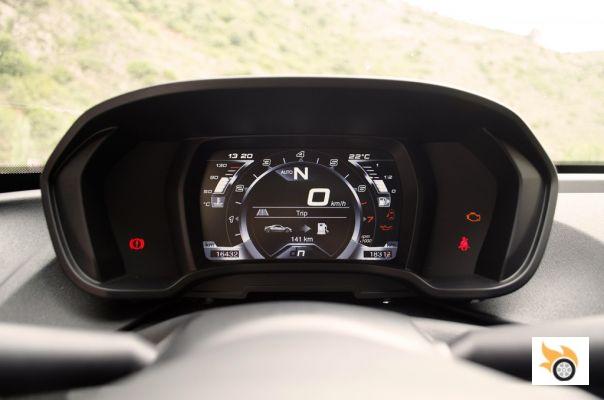 The instrument cluster is replaced by a digital display, as you know. It's a shame to lose sight of the traditional analogue clocks, but the reality is that it's a display with enough resolution to be perfectly visible under any lighting conditions, whether at night without dazzling you or during the day with full sunlight shining on it. The revs are intuitively displayed (they change colour when you're prompted to change gears) and the speed, in digital numbers, is easy to monitor. There is a marker for fuel, coolant temperature and through other screens, indicates boost pressure and, especially interesting, oil temperature (although we feel it's not very realistic, because it always shows 100 degrees, even if you're "on the track" or riding around the city, having that reassuring effect of always showing the same when it falls in an acceptable temperature range).
The instrument cluster is replaced by a digital display, as you know. It's a shame to lose sight of the traditional analogue clocks, but the reality is that it's a display with enough resolution to be perfectly visible under any lighting conditions, whether at night without dazzling you or during the day with full sunlight shining on it. The revs are intuitively displayed (they change colour when you're prompted to change gears) and the speed, in digital numbers, is easy to monitor. There is a marker for fuel, coolant temperature and through other screens, indicates boost pressure and, especially interesting, oil temperature (although we feel it's not very realistic, because it always shows 100 degrees, even if you're "on the track" or riding around the city, having that reassuring effect of always showing the same when it falls in an acceptable temperature range).
Although I'm one of those who prefer the needles of all life, I must admit that I liked and convinced me, although a 458 Italia style frame would have been cooler, but this one weighs less... right? Besides, it adds that recurrent techno touch, that modernity to a car that needs it like this one.
The air conditioning is another peculiarity. There's no air conditioning as standard, it's a no-cost option to save weight. It's necessary, at least in Spain, where the heat of the engine makes you get hot if you're going to enjoy curves for several hours in the middle of the afternoon. The automatic climate control is a separate option, and it weighs even more, and costs money. Does it make sense to equip it in this car? I'm not sure. Certainly it will look better aesthetically in the car, but if you're not going to make long trips, with the air conditioning you're more than served...
There's hardly any storage space. There are no bags in the doors, no glove box (there is a small elastic bag under the dashboard) and all the space is reduced to a chest between the seats, in the division with the engine, which gets too hot (putting water in it will make you not want to drink it later). There, it's true, you can leave your mobile phone, keys and wallet, but it doesn't fall to hand.
The reality of the interior is that it's as spartan, as I said above, as a Ferrari 458 Speciale. So comparing it to a car with any GT aspirations, like a Cayman, would be pointlessly stupid. This car isn't made to travel in full comfort for 450 kilometres or use it daily to commute to work. It's made to drive and enjoy driving; and it lets you know that from the moment you're sitting in it, without even starting it.
It's like a big Lotus. An Elise grown in width, better finished and with a bit more technology and modernity.
By the way, the trunk space, unique and located behind the engine, is more than decent to go on a weekend getaway, alone or accompanied. It fits two large backpacks and a full-face running helmet (or two large helmets and a backpack... or even a professional video camera, a backpack and a helmet, as we found out).
The technique
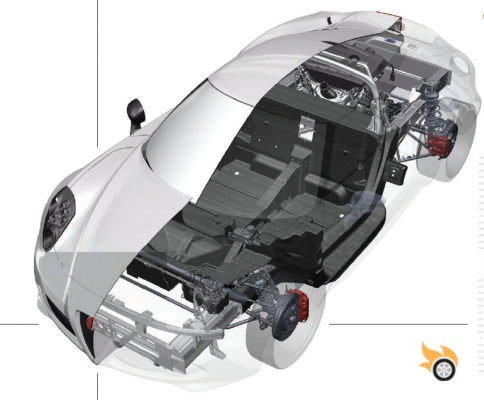
The jewel in the crown of the 4C is the 65 kg carbon fibre chassis.
The technical jewel around which the Alfa Romeo 4C revolves is none other than its chassis. As you know, it's a carbon fibre monocoque with extreme torsional and bending rigidity. It weighs 65 kilograms and to save weight (and cost) it is only painted where the owner sees it: in the passenger compartment.
The car is built around this carbon fibre monocoque. For this, the first thing that is integrated is a safety cage for rollover cases, made of aluminum tubes. Two aluminium profile subframes are used to house the suspensions and the engine.
At the front, two trapezoidal extrusions are used, which project forward to serve as a collapsible structure in the event of an impact, and also give play to the joints of the front suspension, which sits on double triangles superimposed with an anti-roll bar. All the suspension elements are also made of aluminium.
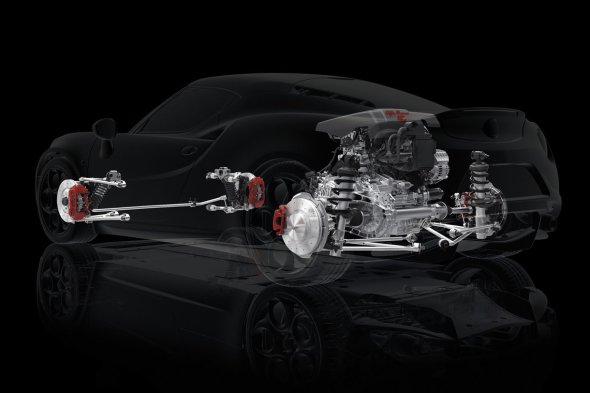 At the rear there is also a tubular structure with extruded aluminium sections, which serves to house and support the engine and transmission and also to provide support for the rear suspension. This is provided by McPherson struts, with a control tie-rod for toe-in. The lower wishbone is also aluminium. The anti-roll bar here is optional and is offered along with a stiffer front for those looking for a slightly more racing and radical ride (we'll talk about that below, as our test unit had the "sport" suspension with the rear anti-roll bar).
At the rear there is also a tubular structure with extruded aluminium sections, which serves to house and support the engine and transmission and also to provide support for the rear suspension. This is provided by McPherson struts, with a control tie-rod for toe-in. The lower wishbone is also aluminium. The anti-roll bar here is optional and is offered along with a stiffer front for those looking for a slightly more racing and radical ride (we'll talk about that below, as our test unit had the "sport" suspension with the rear anti-roll bar).
The braking system is provided by Brembo floating steel discs on an aluminium hood at the front, with 305 millimetre diameters, and four-piston Brembo rigid calipers (this is the same braking system we've seen on many other Fiat Group performance models and are related to the rear brakes of the 360 Challenge Stradale, as I've told you on more than one occasion). At the rear there's room for 292 millimetre discs, rigid, ventilated and drilled, bitten by a single floating caliper.
The entire bodywork is made of plastic panels, some made of composites and others of injected polyurethane. This makes the bodywork extremely light and at the same time resistant to deformations, inclement weather and low-speed impacts. In that sense, it is a car that should stand the test of time better than a Lotus with traditional fiberglass composite bodywork like the Elise.
The bodywork in plastic composite and injected polyurethane, and the aluminium subframes complete a car that weighed 975 kilos on the scales.
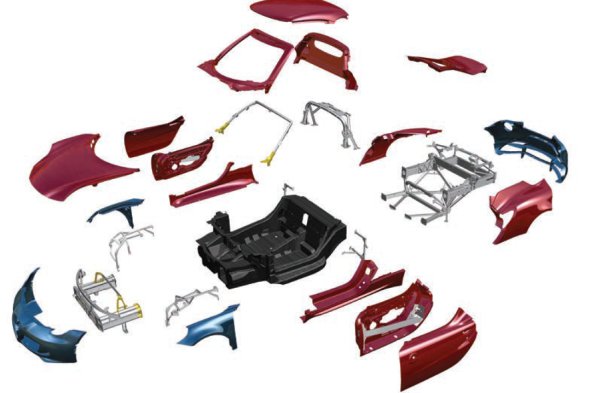
The heart of the beast is provided by the 1.750 turbocharged with turbocharger, variable distribution in intake and exhaust and direct fuel injection. It also has the effect of "sweeping" through the game of variable timing with the opening of valves to generate a vortex in the combustion chamber to keep the turbocharger at a good speed of rotation, even in phases without throttle load, to avoid the dreaded "lag".
It is the "all-aluminium" engine, derived from the original 1,750 developed for the Giulietta QV and 159, which lost 22 kilos compared to the one seen in the C-segment model. It is mated to the firm's TCT dual clutch gearbox, which transfers torque to the rear wheels via a conventional differential. To make up for the absence of a lock-up, ESP emulates the actions of the limited slip differential by acting on the rear brakes.
All of the car's electronics are controlled by a "DNA" controller, which you've already seen in the cabin, with four programs. One is for slippery surfaces (snow, ice, or universal deluge), another "normal" for "smooth and quiet" driving, another dynamic, with lightning fast gear changes, a lot of response with little throttle travel and little ESP action, and finally a "Race" mode, where the ESP goes to sleep.Race" mode, where the ESP sleeps, except for the functions of emulating the self-locking and as a braking stabilizer (it prevents the rear from slipping when trying to do "trail breaking").
In the end, Alfa Romeo says, the aim is to save weight in each and every aspect in order to keep the car under 900 kilos. Thus, for example, each and every one of the vehicle's windows is thinner than normal, exchanging weight for sound and thermal insulation. This quest for lightness pays off. Alfa announces a weight of 895 kilos "Italian style" (dry). The scales one kilometre from my house say it weighs 975 kilos with a quarter tank of fuel. This makes it lighter than a Lotus of equivalent power and virtually any rival on the market. Although the question is perhaps whether the sacrifice in carbon fibre (price) and comfort is really rewarded in driving dynamics. Comparatively, the chassis of a Lotus Elise weighs 68 kilos, 3 kilos more without using carbon fiber, but of course, using fiber gives "cache" and extra rigidity and safety, at least on paper...
Let's go for a drive
I was anxious after seeing the look of the car and settling in the seat to start the beast, as you are anxious now, after swallowing paragraphs of aesthetic and technical explanations. Key in the ignition and half turn to start the engine. There is no starter button.
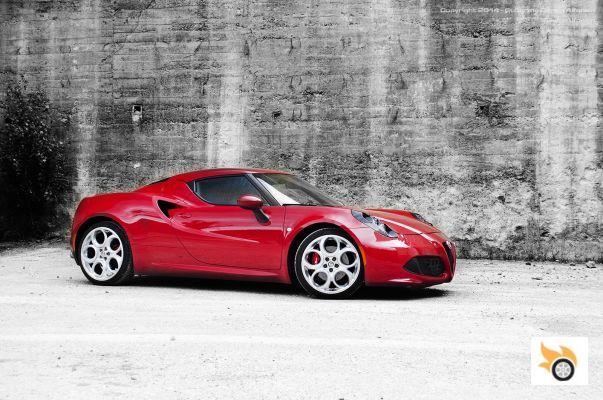
Before, when you open the door, the electric fuel pump and the one that puts pressure to the dual clutch gearbox have already set the car to come to life at the slightest hint of the key, and so it happens. The starting roar is spectacular, dominated by the sound of the exhaust. If you open the door or the window while the engine is warming up before idling, you'll be impressed by how loud the car is, to the point of wondering if it's legal (and then I thought the Abarth with the optional exhausts was outrageous...). Note, the test unit has the optional sports exhaust fitted. Presumably the "basic" exhaust model is somewhat less brutal.
Only the Italians dare to make cars that sound like this. No, it doesn't sound like a beautiful V6 Busso, or a Ferrari flat-shaft V8. It has a less rich and deep sound, more raw and raspy from the outside. The idle stabilises in a matter of seconds and the cabin, with the door closed, lets you hear the engine clearly. Now the harmony is dominated by the relentless rattle of the direct injection that "has something of a diesel engine sound". The injector pump and the opening and closing of the piezo injectors are the winners here.
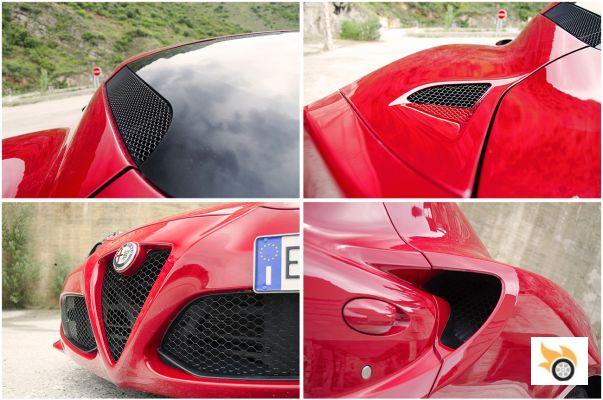
First gear button, handbrake off and you have to give gas to start moving slowly. The gearbox responds smoothly, and the car starts to move. The steering wheel, you know that without assistance, can seem a bit heavy when stationary, but not too heavy for non-assisted steering. You immediately notice that there's little weight on the relatively thin front wheels, and there's little advance in their geometry.
It's breaking static and the steering instantly softens. With more than 2,000 kilometres to cover in three major stages, the first feeling I get is that the adventure is going to be tough. The soundproofing of the engine is almost nil. The suspension, especially hard, and driving the car is "something physical". You have to work at it.
After driving for a while around Madrid, I notice how the eyes are nailed on the red Alfa. It is not a car to go unnoticed. Passers-by even mistake it for a Ferrari. The truth is that despite the complaints I've read and heard about "its excessive width" (including the Top Gear guys), the reality is quite different. It's an easy car to move around town, especially forward. Because you can see the front wheel arches and control the rear, it's easy to get a good idea of where you are and what you're stepping on. Forward and side vision is perfect, and well, rear vision is the typical disadvantage of these mid-engined cars. The mirrors are "half-assed" and remind me of (you guessed it) the ones on the Ferrari 360, showing you the car, but also the bonus air intake. The central mirror complicates things a bit more, because the rear window combined with the firewall behind you make it very dark through the mirror, although it's not an impossible mission. It's clear that if you've been driving a Tiguan on the street, in the 4C you'll feel "very low, very helpless and blind", but if you've driven a few small sports cars, especially mid-engined ones, you'll see that the 4C is very well resolved "for what it is". Here, experience is a degree, and what the people of Modena have learned by making so many Ferraris is noticeable.
Stopping for the first crossroads and traffic lights immediately reveals the hardness of the brake pedal. If you are a regular reader of these lines you will have read me time and again asking for pedals with less servo assistance. The "excuse" is that with them you can modulate the braking more precisely and if possible, without dead travel. Alfa has decided to go exactly that way: the pedal, aided by the rigid calipers, floating discs and first-rate hoses, has no dead travel and goes hard, very hard. In town it makes you work a little harder with your leg to stop the car, but as we'll see later, in any spirited driving it convinces you immediately.
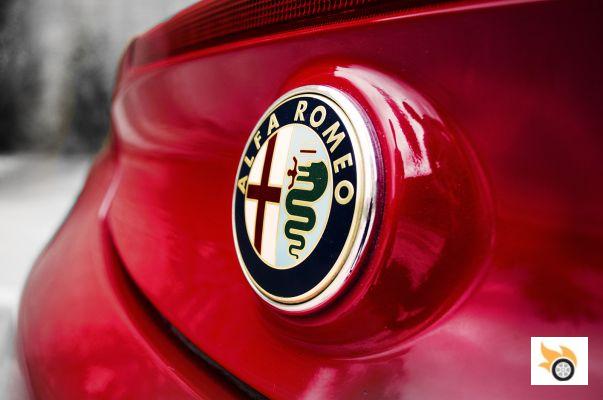
It only takes a few kilometres to realise that the 4C is not a car for long distances or comfortable street driving.
Quickly the cabin gets hot and it's time to turn on the traditional air conditioning, because the bulkhead that separates you from the engine transmits heat, and because the thin windows don't insulate me from the 30 degrees in Madrid or from the sun. It's time to take the open road to make kilometres. Our destination is Calafat, near Tarragona, but first I'll pass through Logroño to pick up the recording equipment and spend the night.
I speed up to get rid of the urban traffic before rush hour arrives. The sensations multiply. The engine is full of torque from very low, from less than 2,000 revs, and its 350 Nm are immediately noticeable with a considerable kick that sticks you to the seat. It does so while a tremendous induction sound dominates the cabin and you hear the turbocharger whistling as it compresses the air... "Shhhhhh". There's barely any lag between hitting the floor and getting the kick, and the engine launches the car forward like an exhalation. I let off the gas so as not to exceed the legal and reasonable limits if you want to keep your driving license and points. The turbo wastegate is also present there with its "pshh".
No, the engine doesn't sound like an old Busso V6. It doesn't sound like an epic Alfa Romeo aluminium twin-shaft. It sounds like a very tight turbo engine. It sounds like a rally car, a Group A car, a tightly wound Integrale. Granted, it's not as delicious, fine, provocative or sexy as the old heart of other Biscione models, but that's the way it is now, with our emissions regulations.
After giving it gas, the car immediately starts to discover things. Keeping a straight line on a motorway or dual carriageway is a job for two hands and a lot of attention. The steering seems to be constantly looking for any imperfection in the asphalt, road surface or camber change to go towards it. The self-centering effect is very little marked, so those first two or three degrees of steering wheel turn are very "light" in your hands, and require you to be alert, with all your senses. At first it's a bit scary to go fast in a straight line for this reason, because it feels like the car, short on power, wants to boogie all the time. The reality is that with the passage of (many kilometers) that we put on roads of this type you end up getting completely used to the steering and quickly learn to trust it more. The car is more stable than it first appears, and although that feeling of lightness from the "centered steering" point never goes away, it's no longer something to worry about when, with both hands on the wheel, you automate your responses and calm down.
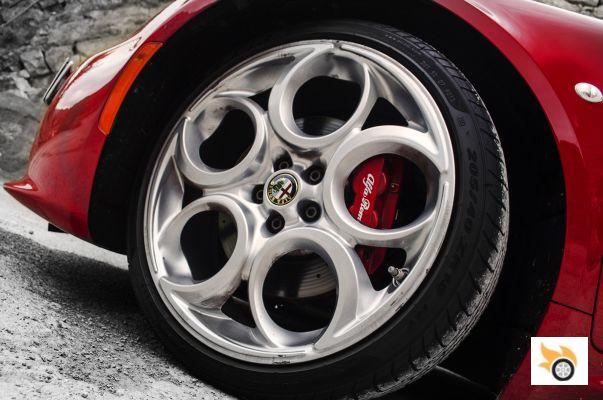
The reason for this lightness at the start of the steering wheel turn? The car implies that the front suspension geometry has low caster. Low caster means less effort when steering when stationary, and also more agility of the front end when you put the steering wheel in to change trajectory. But on the other hand it has the disadvantage of having less self-centering effect. In modern cars with power steering, like the Ferrari, the self-centering effect is achieved by the assistance, getting that feeling of stability in a straight line is magnified and eliminated, in part, that tendency to follow ruts and bumps in the steering.
We continue discovering things to drive on long trips: From 80 or 90 per hour, the radio starts to have problems to impose its tone to the engine. You'll have to take it above three quarters of its full volume capacity to let it be heard. The engine, at constant speed, loses the allure of its puffs, snorts and snorts at load changes, and is left with a rattling tone from the injection system that, as we told you at idle, isn't sexy at all.
Consumption is a pleasant surprise: you can average over seven liters per 100 kilometers, something unthinkable for a car that walks like this... Of course, although it has that advantage, we doubt that many customers will take advantage of it.
The suspension is hard, immovable. Comfort, in this sense, takes a second or third place, and between the engine noise, the rolling noise and that the bumps are transmitted directly to your kidneys, I can tell you that it is not the most comfortable car to do 1,000 kilometers in a day. My passenger, recruited to film the video (video you'll see next week), got into the car with a smile, all happy to discover the 4C, but its non-adjustable seat and the lack of gripping points ended up breaking his back as much or more than yours truly.
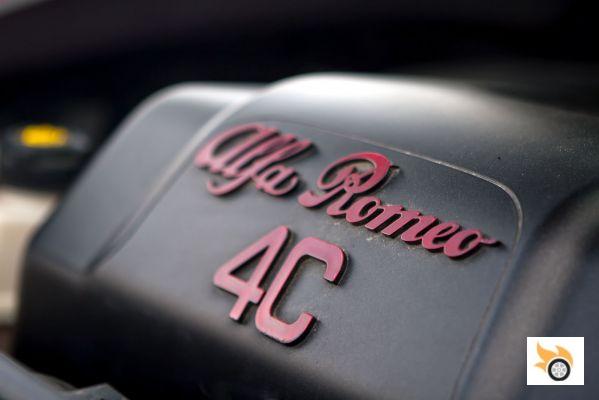
After 25 kilometres, that's all it takes, you start to wonder how anyone in their right mind could have thought of comparing this car with a Porsche Cayman. They couldn't be two more different machines. Where in the Porsche you could do a Pontevedra-Barcelona in one sitting and come out unscathed, in the 4C the punishment in the form of fatigue would be more than obvious. It's a car that tires you physically, but also mentally, because you have to be attentive, more for the work of tracing and driving it, than for anything else. With nowhere to rest your elbows while driving, and with the imperative need to keep both hands firmly on the steering wheel, believe me it's not the car I'd choose to cross the country from end to end.
As I said above, it's a big Elise, a wider Exige S, slightly better finished, more powerful and with a "turbo soundtrack". But for ride comfort, either car offers something similar when it comes to long journeys.
First mountain curves
The first mountain pass to test the 4C and its dynamism, to get to know each other, was Piqueras, between Soria and Logroño, idyllic scenery through which each and every one of the sports cars that I judge ends up passing.
With very good previous references, I put the DNA control in "Dynamic" mode (we'll leave the Race for later, when the girl and I already know each other a little better) and the coitus begins, I mean, the driving.
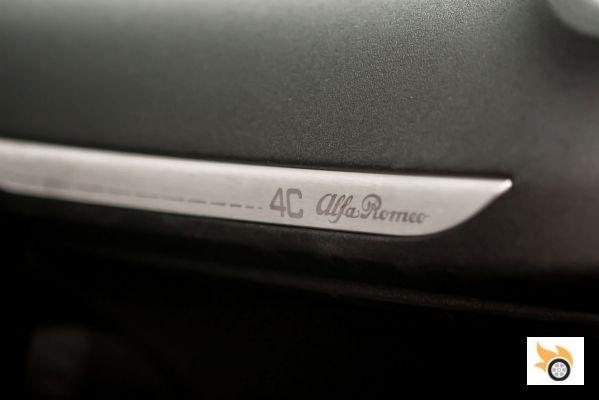
After crossing the tunnel that separates Soria from La Rioja, the pass starts with a series of very fast curves that, if it wasn't an open road, or a closed rally section, would be flat out, cutting the road on all sides. There are expansion joints, potholes and counter-balances. The tarmac is not perfectly dry, with some moisture. I'm afraid that, with that somewhat curly tarmac, the car might move more than I want it to. But it doesn't. Playing hard on the throttle, I sequence the gear changes with the paddles behind the steering wheel.
Unlike what I've seen with the TCT gearbox in the Giulietta, for whatever reason, the 4C responds better, quicker and more attentively to both gear changes and downshifts. The steering is extremely quick.
The car is almost telepathic as you drive it into corners. It reminds me a bit of a Ferrari's steering, in that you barely need to turn the steering wheel to put degrees of turn in the chassis, which requires you to quickly recalibrate your brain so you don't get too far "inside" the turns too soon, something that happened to me at the first roundabout as soon as I took the 4C...
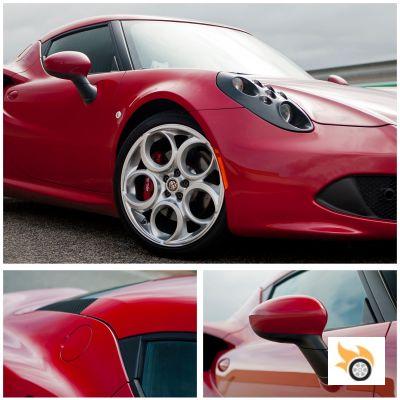
Even though the "break" of the steering wheel's centre point is so light, it gains weight almost immediately afterwards, as soon as the car starts to lean into the corner. The first sensation you get from the car is that the front end bites like very few other cars can do, pulling the front end in without any pitching, without any roll, pulling the car with the rear inscribed as if it were on rails. If you have to shift into support immediately afterwards, the car does it without hesitation, almost faster than you realise it's doing it.
In a fourth-fifth zone, where you come from a right turn over a bridge with two expansion joints, a bit of compression, and you shift left just at the (supposed) rebound of the suspension after that compression, I tend to have some "respect" with other cars, for fear that the damping won't control the rebound properly and the car will do a strange thing by momentarily lightening the wheels. The 4C ignores all problems, turns and bites the corner without flinching. Expansion joints are noticeable. Very noticeable, yes. Like potholes. They reach your lower back and neck, but just because you're suffering in that sense doesn't mean the car is off the road. It goes where you've told it to go. And that's it.
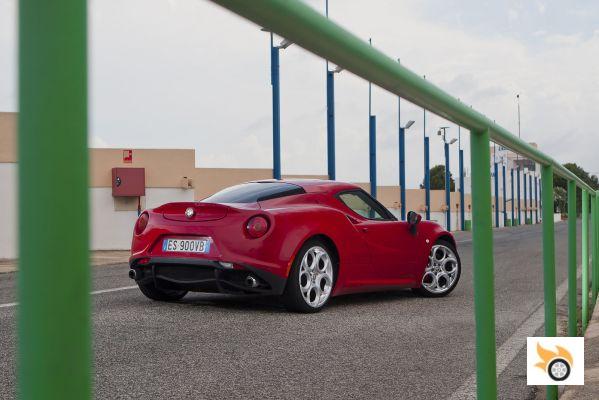
From this fast area you move on to a much slower and more convoluted area, with third and second speed curves chained in threes, which have small, tiny straights that link them.
Here the fun begins, and also at legal speed. After gaining some speed up to fourth, foot on the brake. Firm, but progressive, you can demand everything you want to the front Brembo, which do not flinch and stop the car with panache and perfect control. It's not a car that wants to "trail break", so it doesn't get out of place even if you initiate the turn before releasing the brakes. The gearbox performs the toe-taps beautifully on its own, and responds to our requests at full speed.
The car turns neutral, flat, immediate like any good mid-engined car. Supported, it is imperturbable and you can give gas very soon, without fear of losing the rear for excess of torque, as long as you are progressive with the accelerator.
The first mountain pass reveals a car eager to turn and change direction, neutral and with a brutal cornering.
The steering is perhaps the most peculiar aspect. Being unassisted, it informs you, but it has its peculiarities. For starters, as I said above, it's light around the centre point, but it gains weight, a lot of weight, as soon as you lean into the corner. This makes the car physical to drive, but it also means that the steering isn't particularly "pro-active" in support. In other words, the car isn't nervous once you've leaned on it. At that moment I think it lacks a bit of information on this kind of roads, information voluntarily "cancelled" by the geometry chosen by the Alfa people to make the car feel more poised when cornering.
The Italians say that 90% of the bends can be taken without having to handle the steering wheel, keeping the original position of the hands on the rim. They are right, in fact, I would say that in a pass like this, the percentage is close to 100%.
The engine is another factor that dominates the equation. As was the case in the Giulietta test, I will tell you that this Alfa has nothing to do with the Alfa's of the past. Where a 147 GTA begged for revs, or a Giulia GTA did the same with its loud engine, the 4C is a torquey engine, dominated by the low and mid rev counter. It's an explosive engine, with so much torque that the throttle becomes an all-or-nothing affair. You're either hitting it or you're not. Where an old Alfa naturally aspirated allowed you to go very progressive and modulate precisely how much torque you released to the wheels, in the 4C you go from having nothing or almost nothing, to having everything or almost everything. This complicates and clouds things a bit, if it weren't for the fact that there is so, so much dry traction capacity on the rear axle that, even with these characteristics, you don't have traction problems.
500 kilometres more and second bends
After that first encounter, I go to bed in Logroño with the feeling that the car promises, that it has a beastly cornering, and that it is noble and predictable, but I want more, to get the quintessence, and for that I have 500 kilometers to go, a second mountain road and the big prize ... the circuit.
We have to get up at 4:30 in the morning, to arrive at the agreed time to the circuit and record before in the mountain pass of Tivissa-Vandellòs. We suck motorway for three hours and something, first with the night over us. Here we discover that the LED technology headlights signed by Hella for the occasion are not "the brightest thing in the universe". In low beam they offer a good beam of light, they fill the road well, but the difference with high beam is almost negligible, and when we activate the long beam we don't gain much. I expected more from Alfa Romeo's first "full LED" headlights, we'll see if the 4C Spider's solution gives better results in future tests.
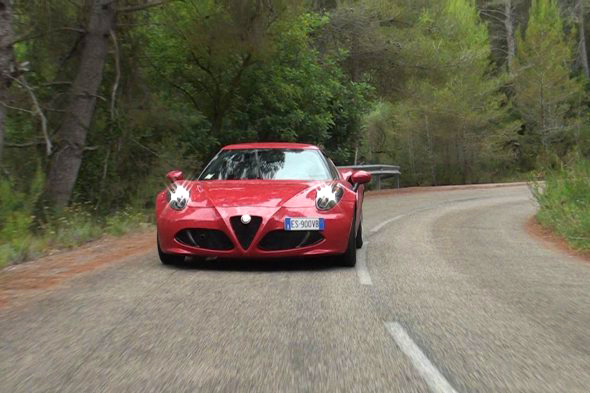
After three hours of "mistreatment" on the highway, we turn to Calafat and take the opportunity to go through the famous and very fast section of the Rally RACC of Santa Marina. The asphalt is wet by the morning mist, the sun's rays are already present, but a fine rain falls and wets everything. In a stretch as fast as this, we can not get to test much of the car, as it would be getting into "extremely illegal" speeds. In any case, every overtake shows us that the engine is a real protagonist, almost in any gear you're in. Just get behind your victim, push hard, and without delay the 4C jumps forward and completes the maneuver in a jiffy.
Tired but with a lot of desire we arrive at the meeting point in Calafat, with Dani Murias, who also has to give us a hand with the recording. After laughing about my dark circles under my eyes and the beating of the trip (I get compliments for having been able to do a thousand and some kilometers with this car without having developed lumbago), we go to make curves on the very convoluted road of "Camí de Gennessies", which has about 24 kilometers of curves, counter-curves, paellas, on a bad asphalt, full of gravel, with paellas and curves of all kinds.
The front end is extremely incisive, and the steering gains a lot of weight when the car leans, something that happens thousands of seconds after you think about it and start to move your hands.
The rain is still not respecting us and the asphalt is still a bit wet, which adds the factor of discovering if the 4C bites or is tame... After a mental warm-up by taking shots with the "camera car" for the video, I go to "test" seriously, while we take pictures in motion. With a much more twisty port than Piqueras, the 4C demonstrates the advantages of a much shorter and compact car than a Ferrari.
Its mini-supercar status is an advantage here.
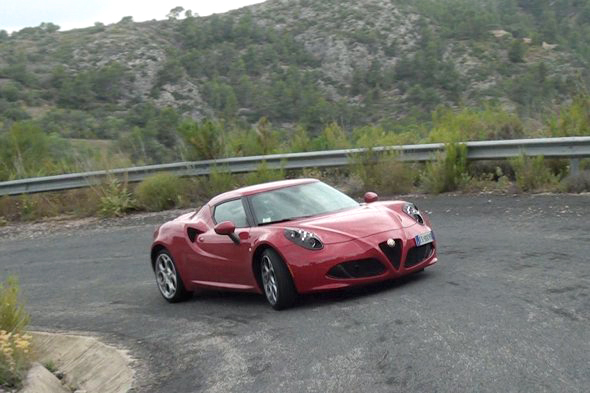 its turbocharged engine, too. Used as if it were a tarmac rally car, the 4C becomes a sort of Lancia Stratos for a few hours.
its turbocharged engine, too. Used as if it were a tarmac rally car, the 4C becomes a sort of Lancia Stratos for a few hours.
Full throttle, finding traction is still easy, I go downhill and then the road changes to a steep incline, where you have to brake up a bit to stick to a second left-hand corner followed by a blind right-hand one, which leads to... a bunch more corners before reaching a paella.
The change from downhill to uphill happens without pitching, which also doesn't show when switching to the brakes. Despite abusing them, the hard and dosable pedal allows me to manage the piston with precision, I change support quickly, I throw myself into the left-hand corner, the steering marks the trajectory, the car follows without delay and the rear doesn't come off. I keep some gas for the next corner, I accelerate on the exit, the car doesn't get loose.
The asphalt is not at its best, the next curve shows it, another slow left turn in second, I put the steering wheel and the car struggles to register for lack of grip, not so much the fault of the 4C but rather the floor and moisture, here I find how the limits of the car are dragging forward first, for, once regained composure, return to stick to the line "as if nothing had happened. The loss of front wheel drive is followed by small virtual "jumps" of the wheels, which struggle to bite the asphalt. The good thing is that it is something predictable, dosable, where with a little hollowing your demands (whether accelerator or steering angle) is recovered. The problem is that the steering wheel, which gains so much weight as it hits the corner, barely lightens up to telegraph to you that the car is going to go forward. In that sense the 4C is a little reminiscent of... the original Stratos! I would even say that it also reminds you of its reinterpretation that we tasted in Mallorca a little more than three years ago.
Apart from that, the rest of the hairpin bends are easy prey for the 4C. The engine, so supercharged and with so much torque, eats up everything, and even if you're in the wrong gear, you can give full throttle and come out of each and every corner strong, without having to look for the "good zone" like a desperate person with a naturally aspirated engine.
If you're up for it, you can round corners purely on power by applying the throttle at full throttle, but the Alfa lets you drive the way you want to. You'll be quicker by pulling clean lines and by applying (as little as you can) throttle. If you're quicker with your right foot, you can make the rear tyres smoke a bit (see photo), but you won't get any pleasure out of it.
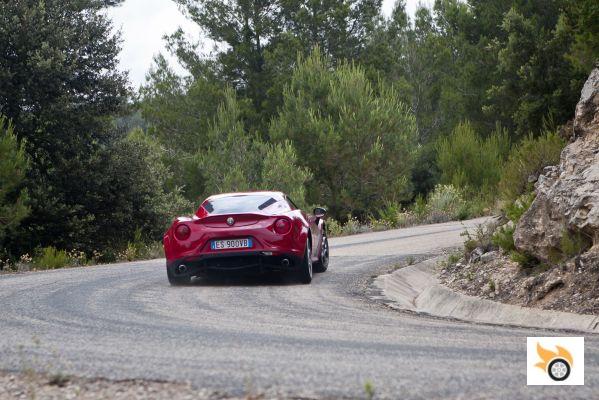
It happens to the 4C here as it happens to the Lotus Elise: You don't need to go sideways, drifting and breaking speed records to enjoy it. The simple accumulation of sensations, the work on the steering, the thrust of the engine, the feel of the brakes, the way you hear the gravel jumping on the fibre underbody, the maximum concentration you have, the perfect work of the gearbox, everything makes that, even going at 70 or 80% of the car's capable pace, you stay hooked and fall in love.
The width of the car is still not a problem here, even though we are talking about a very twisty and narrow track. Thanks to the sharp, raised wings, you can position the wheels perfectly and predict where you have each of the four wheels, which is very important. And because the car is so short of track, it is not at all clumsy, neither in the changes of support, nor when asked to enter or exit the curves.
When you get to the paellas, you barely have to put the steering wheel in to negotiate them, and the explosion of torque when you put the gas pedal to the floor allows you to play with the rear if you want to round it off with a small angle of "attack". It's not a car, as I say, to go "sideways". As a good mid-engine with a low polar moment of inertia, you wink a little and you quickly go straight.
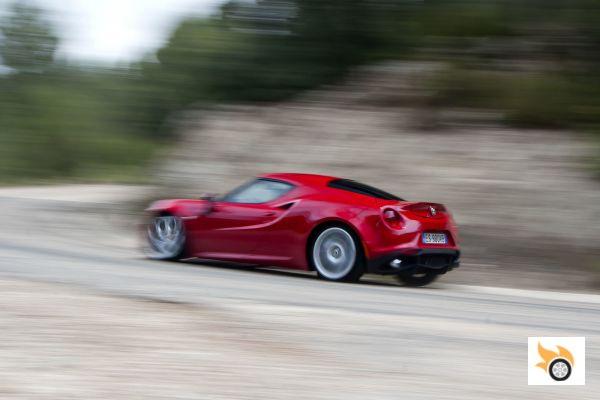
The final tendency is to understeer, and the rear can be brought into play with the throttle, but it's never a critical car that will make you shoo backwards in the dry.
Compared to an Elise, in the same section, I do miss, clearly, some more communication from the steering, which has a good feel, precision and speed, but it seems to me too little communicative for what it could be. I understand that Alfa people have opted for this way to make the car easier and more affordable for anyone, so that they do not exceed the data, but an Elise (especially an S1) "tells you more".
The immovable rear and the stabilizer tuning make the 4C not relocatable in dry under deceleration. If you want to skid from behind you'll have to do it by pure throttle, and that can take away some agility on corner entry or in full support if you've missed the apex. The test unit partly solved this with an optional rear stabilizer, but compensated with a thicker front stabilizer than the stock one. You could certainly make the car more aggressive in this respect with a hair more rear stabilizer (or a hair less up front), but that would compromise that "car for everyone in all conditions" factor, because it would compromise wet handling (more on this below). It's fine as it is, more so knowing that we'll probably see a "Quadrifoglio" version in the short term, with a slightly more radical approach.
It's time for the track
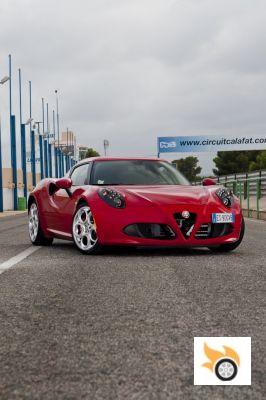 After a morning of mountain corners, it's time to test the 4C on a racetrack, and here the rules change. And here the rules change: will a car as agile and short as this one be stable on long downhills and straights? Will I crash before the end of the day, given that I've never driven it at Calafat, even though I've been there twice before?
After a morning of mountain corners, it's time to test the 4C on a racetrack, and here the rules change. And here the rules change: will a car as agile and short as this one be stable on long downhills and straights? Will I crash before the end of the day, given that I've never driven it at Calafat, even though I've been there twice before?
I wait for the customers to finish their laps and I stay in the pit lane. I take a deep breath, put the "Race" mode on the DNA controller (five seconds in a row on the key in dynamic mode will give way to this mode).
I go out to reconnoitre the track with a couple of laps to test braking and cornering and guessing gears. Calafat is an old circuit, only Jarama is of his fifth, and for years is banned to national races, due to security problems (minimum run-offs with concrete walls very close), but it's a short, twisty and without big fast corners or elevation changes that complicate your life.
After acclimatization and recording laps in the circuit again with camera car, I start to get serious, while we make the videos of the passes, and begin to explore the capabilities of the car.
A lap of Calafat starts with a short straight. Pedal to the floor and you can get to sixth gear, and glimpse the 210 per hour, before the first left elbow that is made by hollowing the throttle before moving to the brakes to face the first interesting curve, a second right turn. With the 4C I cross the finish line with the soundtrack of the engine reminding me of a rally car with the turbo blowing covering almost all other environmental factors. Dubitative I hollow out earlier than I can (Miki Monrás was there and he told me that I could stretch up to 225 before hollowing out for the elbow, but being a rookie on the track I didn't set out to explore that...).
At those speeds, before you get to the point of "cupping", you forget how light the steering is in a straight line. The aerodynamic design of the car achieves ground effect and downforce, and that's without resorting to false or movable spoilers. The aerodynamic work is noticeable, and the car is stable at high speed, you notice how it sticks to the asphalt.
When you ease off the throttle and throw the car into the apex, it does it without a glance, without an adrenaline rush. It goes where you tell it to go without you noticing the rear end lighten, and without the car pitching forward in an exaggerated way. With room to move on to the brakes. The braking is powerful, right, and putting some steering wheel in its final stretch, although you have to start a little open and throw something late to the apex.
Again, although here you get to much more speed, the 4C shows that it knows a lot about braking, and the hard pedal allows me to make regressive braking, very strong at first, to be released at the end while I register the car in the curve.
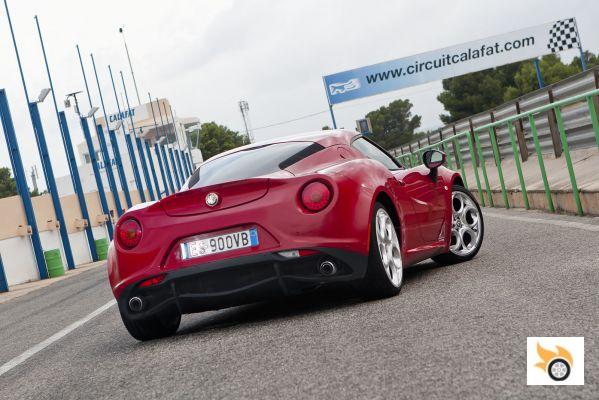
On the track the experience becomes addictive. It communicates and talks to you. It could have a steering that talks to you more, and it could have a more adjustable rear end, but as it is, it's fun for everyone, even at 70% of its potential.
The nose goes into this smooth tarmac like a raft of oil (the track was recently re-asphalted), and steers me without complaint to the apex as I apply full power for a short straight where you get up to fourth before the braking point. The rear barely hesitates when you unload all the torque, the car settles back and pushes without skidding more than a tenth of a degree.
The short straightaway takes just over two seconds as you head straight into a wall. You have to stop until second for a rather long left hand round corner that you take very lean.
It's one of the two corners where I can put the brakes to the test and play with the braking pressure. I delay as much as I dare and I go to the pedal. The car is capable of 1.2 G's of maximum deceleration; and they are noticeable. The pedal, when you go flat out with it, has very little travel, and it surprises you, because although it is very hard and modulable, it seems to hide some more power in those last two or three millimetres of travel, which you can't quite find. Anyway, it doesn't lack braking or stability. ABS doesn't come into play, and that speaks volumes about the grip available.
With the speed turned into heat in the brakes, I pull the steering wheel to the apex of the corner and lean the car hard, the steering gains a lot of weight again. If you enter this corner too hard, the nose inevitably drags outwards, with reassuring understeer. You don't open the nose much (unless you boil the turn by a lot), and as was the case in the mountain pass, with a little hollowing you recover the place, but I'm still missing some information to finish rounding the equation. Playing with this same curve, you can slide from behind, if you enter softer and, playing with the inertias, you give a lot of gas, but it's not more effective than a clean line.
With the clean line negotiated, you spit into the piano on the outside of the corner, and this directs you full throttle into a piano on a blind downhill left hand corner, a very shallow elbow that is "flat out" (they say), before you go on the brakes like a madman to stop the car and negotiate another long slow right hand corner. Braking in support is, again, reassuring, with no rear-end spooking. Hitting the kerbs is no problem for the 4C, which does it like it's nothing, and the traction and cornering ability continue to impress me.
The next area, the counter-legends, is a succession of three corners in a row, complicated to drive "clean" at first (I needed more time to find the perfect line), but at the end of the day I found myself cutting the kerbs and braking on the banking, playing with the inertias. Here the car is physical. You have to work hard on the steering wheel with your forearms, it's not a modern assisted car, it's a car that asks you to drive it, while it transmits sensations.
It takes the punishment of the circuit lap after lap without the brakes complaining. The engine has a lot of power, but it lacks a more "pure" sound if you are of the old school.
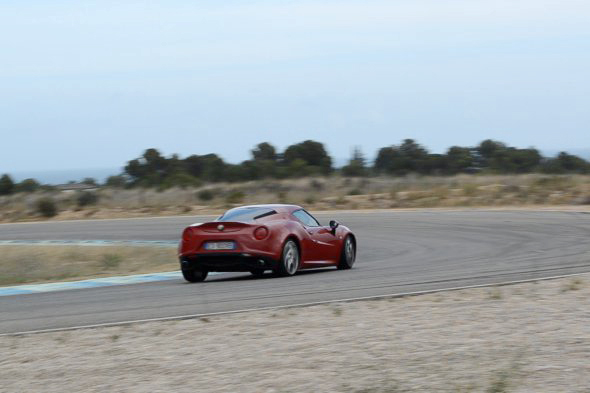 You may miss the gear and be in third instead of second at some point, but the torque will ensure that, while you won't negotiate the stretch as fast as you could, there will be engine to get you out of there like a rocket. If you get the backing wrong, are slow to brake or need to correct, there's sublime nobility. The 4C doesn't bite, it lets you do it, and although you have to work at it to go fast, as I said above, it's a car that gives you that positive satisfaction of going fast, of being entertained, and of having a sort of racing car in your hands.
You may miss the gear and be in third instead of second at some point, but the torque will ensure that, while you won't negotiate the stretch as fast as you could, there will be engine to get you out of there like a rocket. If you get the backing wrong, are slow to brake or need to correct, there's sublime nobility. The 4C doesn't bite, it lets you do it, and although you have to work at it to go fast, as I said above, it's a car that gives you that positive satisfaction of going fast, of being entertained, and of having a sort of racing car in your hands.
So you end up heading to the last three corners of the circuit, two right handers linked by a short straight line for which you have to brake well, and a very slight left hander that leads to the finish line. The first corner requires you to brake hard from fourth to second. You pull the left cam to downshift and the gearbox responds immediately, you enter the corner, and one more is done; although if you go too far with the steering wheel, some understeer appears again. The last two corners are a little different, you stop a little less for the penultimate one, and the last one is a hard left hand elbow that spits you out onto the finish straight moving slowly towards the pit wall as the turbo sonatina engulfs you.
Lap after lap the confidence grows, and the car continues to respond. The brakes don't get tired, they don't get fatigued, even with 40 minutes on track, and the tyres, some Pirelli PZero "of the good ones", hold up well to the mistreatment.
I relax a little and do a slow lap to cool down the brakes before stopping completely. I reflect: I've had a great time. It's a car of emotions, it's a hardcore car, physical, radical, that demands that you work it with arms and legs. Hard in that sense. But at the same time it's a car tuned to be easy and noble. It understeers, maybe a bit early, and finding yourself in a situation where the rear bites you is complicated, because it's very settled and the ESP is always there, in latent mode in Race mode, in case you lose the car by playing at balancing the inertias under braking (and only under braking).
The engine is a splendid torquey, thrusting machine. It lacks a nicer sound and a better pull. You find yourself shifting most of the time at five thousand and some because it's a torquey engine, not a torquey one. This benefits the fact that you don't have to constantly go to the cut looking for the right gear, but you miss an Italian V6 Busso-like naturally aspirated in that sense. Also, the throttle is very forceful in the Dynamic and Race programs, and it puts so much torque so fast that you can't dose it when you want to play with the rear. In any case they are "minor faults or peculiarities" for a superb set to have fun in a corner.
Back home and conclusions
 After having a great time in Calafat, I still had more than a thousand kilometers to go back home, take the photos and return the car to Fiat in Madrid. The beating on motorway and dual carriageway was light, because I had already got used to the car and understood its idiosyncrasies. It's not a GT. It doesn't want to be. It's a tough, arduous machine. It doesn't want to be a 458 Italia, it wants to be a 458 Speciale. It gets it.
After having a great time in Calafat, I still had more than a thousand kilometers to go back home, take the photos and return the car to Fiat in Madrid. The beating on motorway and dual carriageway was light, because I had already got used to the car and understood its idiosyncrasies. It's not a GT. It doesn't want to be. It's a tough, arduous machine. It doesn't want to be a 458 Italia, it wants to be a 458 Speciale. It gets it.
I was thinking of talking about how a little more stabilizer at the rear and a little less at the front could make the perfect combination for this basic version when I was crossing Piqueras, on my way back to Madrid, and the universal deluge fell on me. Between puddles and rivers on the asphalt, and without going "fast as a bullet", in the middle of a long curve in third I found myself doing a 90 degrees counter-steer while I had the same face as when years ago I got the handlebars of the bike in my hands going down a mountain pass... (that's another story to tell). After counter-steering and saving the situation and the car, I recalibrated my thoughts. In the wet this car few people will go to squeeze it in the mountains, but those who do have to be able to do it safely, and in that sense Alfa has succeeded in making a tuning "for everyone" and not a radical "a la Lotus Elise S1", which ended with some people complaining and complaining about their behavior something critical.
We ended up falling in love with it, with its line, with its manners. We didn't expect it to be so "hardcore" and radical, but it's a car that exudes Italian DNA, Alfa DNA reinterpreted in the most radical key seen in the brand.
After returning the car to its rightful owners, but not before regretting not being able to keep it for myself forever, it was time to evaluate everything as a whole.
What is the Alfa Romeo 4C? It's a masterpiece of aesthetic design, that's the first thing. Ok, here you can give your opinion, there are colours to suit all tastes, but in real life it's a beautiful car that makes you fall in love with it and catches your attention.
It's also the "first pure Alfa Romeo Alfa Romeo" in a long time. In 30 years, in fact. Since the SZ by Zagato, Alfa hadn't had a car made by and for them, exclusively. Neither the GTA (on a Fiat platform), nor the 8C (which was a cut-down Maserati) were "pure Alfa Romeo" in the strict sense of having had the freedom to make a car from scratch to the brand's liking.
It's a pure and, above all, tough car. It has no clear rival in the market. It is a "big" Lotus Elise, better finished, more powerful (and more beautiful). It has nothing to do with a Porsche Cayman, which is more GT, and less radical in all its approaches. Yes, the Porsche may be more effective, handles bumps better, has a more elaborate tread and is better made in its cabin, but it's like comparing an electric guitar with a violin... Although they are similar in many ways, they are not used for the same thing, nor do they have the same target audience.
Alfa could have gone in a more GT direction and they would have run into the problem of creating a rival for the Cayman, for which they had no budget, and in which they would have failed. They could have made a more radical car in tuning, with a more agile rear end and more communicative steering, but they would have over-complicated the recipe, and created a dangerous car for the vast majority of its buyers.
The 4C has its faults, like all cars. It has things that everyone would change, but it's perfect as it is, especially for Spanish mountain roads, for weekend outings and for eventually going to circuits. It's not a car for everyday use, it's not a car to go to the Nürburgring from Barcelona, drive it and come back, because you'll end up worn out (although I'm sure crazy people like you or me would do it).
But as a whole, it's a car that has... character. It's a car that transmits. It tells you something. It only takes two kilometres for it to talk to you and explain who it is and what it wants. It doesn't leave you indifferent, and what's more important, it doesn't look like any other car.
I'll tell you more, the 4C is a car that no other manufacturer of Alfa Romeo's size could ever dare to make. A Germanic car would never approve such a radical and uncompromising car, with so many edges and vertices in its personality. Neither Porsche, nor Audi, much less Volkswagen, could present such a focused car. Lotus is far from having the aura of the Alfa due to its current economic situation, and has a ridiculous sales volume. And we have Alpine, we have to see what they get, but something tells us that the Renault subsidiary will end up going more for Porsche than to get where the Italians have gone.
If Alfa Romeo has to be the step immediately below Ferrari and Maserati in everything, the 4C is perfect at it. A sort of "mini-Ferrari", reminiscent in some ways of the legendary Lancia Stratos, but without the uncontrollable rear end skidding. A tame, modern Stratos? It also has something of Ferrari F40: spartan, carbon fibre, turbo engine with supercharged sound, brutality... But in the end the 4C is a car with its own personality that shines. It's an Italian car, pure and simple. It's an Alfa, but it's a reinterpreted Alfa. It takes the original DNA of its ancestors, but it doesn't settle for it, it reinterprets it in a technical and modern key. I don't remember any Alfa so radical and focused on pure enjoyment.
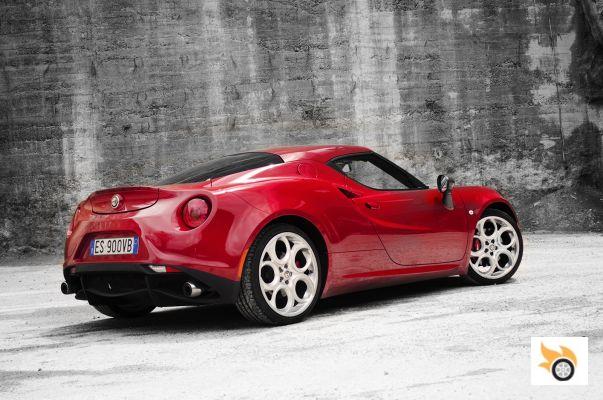
The question is to know how much of this DNA can be transferred to the new models in the range, which will have to offer the ability to be used for everything every day.
The question is not whether we'd want it, which you can assume we would. The question is whether this dose of statement of intent, of personality, of character, will end up being embedded in the brand's future models. Because in the Giulia, Giulietta and company that are to come, Alfa will not be able to pull extremisms like those of the 4C, and when it has to start using compromises to be good in more than one aspect is when you can risk losing that Italian personality that the 4C exhales in abundance. That's where the success or failure of the brand will lie, in knowing how to capture the DNA of this car, its character, and transfer it in small doses to civilized cars usable every day.
While we see if they get it or not ... we will start saving to see if we can put a 4C in our garage to stay. Few cars so uncomfortable, with so many drawbacks, can make you fall in love with them so much... Irrational surrealism. The relationship you have with cars like this one is so similar to the relationship you have with women that maybe that's the key to defining a "passion for the brand".

























